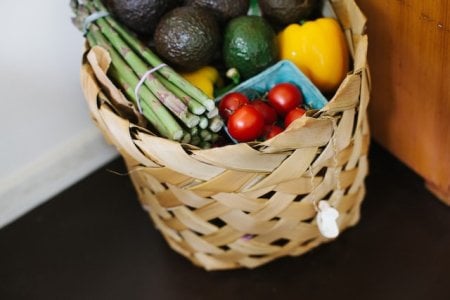Is this the best time to buy vegetables?
By
Seia Ibanez
- Replies 9
We all know how expensive groceries can be, especially when the prices of bread, meat, and dairy start to soar. But there's still some good news to be had because you still have a chance to save when it comes to your weekly shop.
The price of certain vegetables has been slashed by as much as 50 per cent, giving shoppers the chance to save big on one of their staples: fresh vegetables.
According to data from Deakin University's Global Centre for Preventive Health and Nutrition, the price of zucchini, cucumber, tomatoes, red capsicum, broccoli, white cauliflower, avocados, and lettuce have all dropped significantly over the past year, with anywhere between 30 and 50 per cent reductions in cost for some varieties.
For example, in 2021, tomatoes were sold at $8.30 per kg, whereas now they can be found for just $4.21. Red capsicums experienced a similar price change, with prices nearing $7.40 per kg in 2021 but dropping to $5.16 per kg in 2023.
The massive price drop is because of the optimum weather conditions, which led to an ‘oversupply’ of stock.
Michael Whitehead from ANZ Agri-Insights said that anyone shopping for a fresh vegetable bargain should definitely take advantage of the low prices and stock up this season.
'Last year we had the floods, and so consumers will remember that prices were overly high, now (we have) the opposite because of good sun and good rain at the same time,' he said.
'Prices are much lower than they normally would be,’ he added.
While this is good news to shoppers, this brought some challenges to farmers like third-generation farmer Catherine Velisha, who works at a broccoli farm in Werribee, Melbourne.
Due to the falling costs, Velisha's broccoli crop has halved in value, with the prices dropping from $700,000 to $420,000 since last year. Additionally, the costs of fuel, power, and packaging have also increased.
Velisha said that shoppers could help farmers by buying more and taking advantage of the price drop.
'Price-wise, it's really great for the customers, so hopefully they'll take advantage of that,' she said.
'All we would need (to meet those requirements) is to eat one more serve of vegetables and that could change things for us as an industry by a huge amount. So go buy your veggies.’
Similar to Velisha’s situation, livestock farmers and butchers are reportedly affected by the price drop. In a previous article, reports showed that the prices of meats have become cheaper.
Farmers claimed that the collapse in retail prices was not matched by the decrease in livestock prices. You can read more about the story here.

What do you think about this story? Have you stocked up on essentials? Let us know in the comments below!
The price of certain vegetables has been slashed by as much as 50 per cent, giving shoppers the chance to save big on one of their staples: fresh vegetables.
According to data from Deakin University's Global Centre for Preventive Health and Nutrition, the price of zucchini, cucumber, tomatoes, red capsicum, broccoli, white cauliflower, avocados, and lettuce have all dropped significantly over the past year, with anywhere between 30 and 50 per cent reductions in cost for some varieties.
For example, in 2021, tomatoes were sold at $8.30 per kg, whereas now they can be found for just $4.21. Red capsicums experienced a similar price change, with prices nearing $7.40 per kg in 2021 but dropping to $5.16 per kg in 2023.
The massive price drop is because of the optimum weather conditions, which led to an ‘oversupply’ of stock.
Michael Whitehead from ANZ Agri-Insights said that anyone shopping for a fresh vegetable bargain should definitely take advantage of the low prices and stock up this season.
'Last year we had the floods, and so consumers will remember that prices were overly high, now (we have) the opposite because of good sun and good rain at the same time,' he said.
'Prices are much lower than they normally would be,’ he added.
While this is good news to shoppers, this brought some challenges to farmers like third-generation farmer Catherine Velisha, who works at a broccoli farm in Werribee, Melbourne.
Due to the falling costs, Velisha's broccoli crop has halved in value, with the prices dropping from $700,000 to $420,000 since last year. Additionally, the costs of fuel, power, and packaging have also increased.
Velisha said that shoppers could help farmers by buying more and taking advantage of the price drop.
'Price-wise, it's really great for the customers, so hopefully they'll take advantage of that,' she said.
'All we would need (to meet those requirements) is to eat one more serve of vegetables and that could change things for us as an industry by a huge amount. So go buy your veggies.’
Similar to Velisha’s situation, livestock farmers and butchers are reportedly affected by the price drop. In a previous article, reports showed that the prices of meats have become cheaper.
Farmers claimed that the collapse in retail prices was not matched by the decrease in livestock prices. You can read more about the story here.
Key Takeaways
- Vegetable prices in Australia have plunged to record lows, encouraged by optimum weather conditions that have resulted in an oversupply.
- Analysts have highlighted that the price drop is the best value seen in years, with some varieties seeing reductions of 40 per cent.
- Despite this being good news for consumers, farmers like Catherine Velisha, a broccoli farmer based in Melbourne, have experienced significant losses. Velisha's crop value has dropped from $700,000 to $420,000 amidst rising costs for power, fuel and packaging.
- The article also highlighted the low vegetable intake amongst Australians, with only six per cent of children and one in seven adults consuming enough vegetables daily.
- Velisha encouraged Australians to buy and consume more vegetables, not just for their health but also to support the farming industry.
What do you think about this story? Have you stocked up on essentials? Let us know in the comments below!








